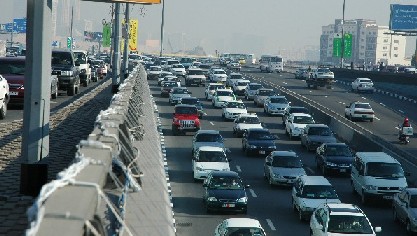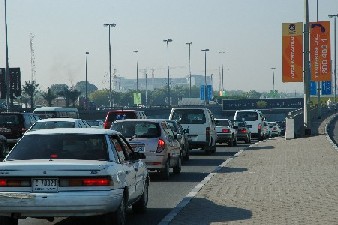|
Owning a car is a commonplace
affair in Dubai. Rising fuel costs, which drivers in
most other countries throughout the world have to face,
is not something that Dubai motorists have to worry
about. Add to that the benefits of a tax-free
environment and it becomes quite clear why personal
vehicles are the most preferred means of transportation
in the city at the moment. However, Dubai residents have
now started to experience the negative sides of having
that many vehicles on the road.
Traffic congestions have become a part of the city’s
daily routine and lines of queuing cars, often times
several kilometres long, are now a common sight at key
junctions and roads. A resident in Dubai’s Greens
development said the 30-kilometre commute home currently
takes her twice as much time as it did a year ago. “The
situation is becoming more and more difficult every
month,” she said.
A look at Dubai’s demographics reveals that traffic
congestion will remain an issue for the city’s residents
for some time to come. Currently there are 465,000
vehicles registered in Dubai, in addition to 5,000 taxi
cars. However, there is a significant amount of
residents of neighbouring emirates who are working in
the city. This means there are more than a million
vehicles on Dubai’s roads, making an average of 3.1
million trips each day. What is more, the number of
vehicles in use is increasing rapidly.
The annual growth rate of vehicles in Dubai is currently
12 per cent and the growth pattern is likely to
continue. It is expected that Dubai’s population will
reach four million in 2020, while the number of trips is
expected to go up to a staggering 13.1 million trips per
day.
Clearly, the
current road network needs an improvement and this is
exactly what Dubai Municipality is planning to do.
According to Eng. Nasser Ahmed Saeed, Director of Roads
Department and Coordinator of Dubai Light Rail Transit (LRT)
Project, a total of around Dhs.4 billion (US$ 1.1
billion) will be invested in Dubai’s road system in the
next couple of years. This is a significant investment,
considering the fact that the net worth of the city’s
road network currently stands at Dhs.9.1 billion (US$
2.52 billion).

The plans include extensive improvements on one of the
city’s main arteries, Sheikh Zayed Road. Also pending is
a forth crossing over the Creek, near Festival City.
This will help facilitate the flow of traffic between
Deira and the rest of the city, which is currently a
major problem. The fourth crossing will connect to a new
road, parallel to Sheikh Zayed Road, which will run from
the Sharjah border to Abu Dhabi. There is more good news
for those driving to and from Sharjah as new lanes will
be added to the Emirates Road to cater to a larger
volume of vehicles. In addition, there will be a bypass
from the Emirates Road to the capital, which will be
used by heavy vehicles.
Dubai’s major streets will soon boast a variable message
sign system, which will be providing motorists with
updated information on traffic conditions, thus helping
to avoid jams. Most of the above-mentioned projects will
be finished by the end of next year.
While there are substantial improvements coming up, they
are not likely to eliminate traffic problems altogether.
“Sometimes problems cannot be solved by an engineering
solution as the volume of cars is much larger than the
capacity of the road network,” Saeed said, adding “It is
wrong to say that you can always solve traffic problems
by building new roads and bridges”. According to him,
often times it is a question of managing the existing
road network rather than enlarging it.
Saeed stressed on the need to put more control on the
roads so as to better manage the traffic flow. Better
management includes restricting the hours during which
heavy vehicles can use the roads and having slightly
different working hours for the various sectors in the
economy to avoid large aggregations of cars at
particular hours. Collecting toll at the busiest
highways is another option, which the Municipality is
investigating at the moment.
One solution to the current traffic problems is to
encourage more people to use the mass transit bus system
in the city. “Improving the mass transport system is one
of the most important ways [to manage traffic],” Saeed
said. At the moment, some 200,000 passengers are using
the bus network every day. Although there are no
statistics on the issue, Dubai bus users seem to belong
to the lowest earning portions of the population with
higher-earning professionals deeming car ownership a
matter of prestige.
Saeed is determined to change this. “If there is a
good-quality door-to-door service available, then, there
is no need to have a car,” he said. According to him,
customers should not walk for more than 300 metres to be
able to take advantage of the bus service. Currently
there are 537 busses in Dubai, serving 58 routes. The
municipality plans on increasing the number of busses in
an attempt to service a bigger part of the city. Plans
are also underway to improve the lay-bys on each route
to make waiting for the bus a more pleasant experience.
A major solution to traffic congestion problems is the
Dubai LRT project, which the municipality has been
researching and designing since 2003. “Dubai metro will
be a solution to so many problems because one lane of
metro equals up to 60 road lanes,” Saeed said. The
benefits of the light train project include reducing the
number of cars on Dubai’s roads, facilitating traffic
and increasing road safety. The project is also an
environmentally-friendly alternative to cars and busses
and will help reduce pollution in the city. With a
carrying capacity of up to 50,000 passengers per hour,
the mass transit system will be able to meet public
demand until well beyond 2020.
Currently the Dhs12.5 billion (US$ 3.47 billion) project
is at its final stage of bidding and five consortia have
been short listed for making final offers. “We have
finally completed the detailed engineering and project
design and the document has been made available to the
five bidding consortia to make their offers,” said Saeed.

The bidding process has two stages. Technical bids have
been submitted already, while the commercial and final
bid is scheduled for 28 February, 2005.The consortia are
expected to attach a financing solution along with their
offers that will cover 90 per cent of the project’s
cost, with a repayment and recovery schedule ranging
from 12 to 20 years, mostly from the annual operational
income. The Dubai government will invest the remaining
10 per cent of the balance. The contract is expected to
be awarded by March or April 2005, with site work to
start in May 2005.
Phase 1 of the project covers 43 kilometres and will run
from the Rashidiya depot to the American University of
Dubai. Completion date for Phase 1 is May 2009. Phase 2
will add an additional 29 kilometres to the network,
covering the distance between the American University of
Dubai and Jebel Ali Port. Another line will connect the
Dubai Airport Free Zone and Dubai Healthcare City. Work
will start after the completion of Phase 1 and is
scheduled for completion in 2012.
Both lines will feature elevated and underground
sections with two interchange stations at Union Square
and Bur Juman.
About 30 per cent of the project will be underground,
while the remainder will be on tracks elevated above the
ground. The underground system will be implemented in
the central parts of Dubai to preserve the city’s
beauty, while elevated tracks will be built in the
external parts of the emirate.
There will be a total of 55 stations built at one to
three kilometre gaps. There will be 99 trains each with
five compartments, including first class and a special
compartment for women and children. The trains will be
automated and there would be no drivers operating them.
There are also plans to use the network to transport
goods around town during night in order to make the
project more feasible.
According to Saeed, the project will generate more than
Dhs.500 million per year (US138.8 million), $ with a
possible fare structure averaging Dhs.3 per person per
trip. Operational and maintenance costs are expected to
come at Dhs.200 million per year.
Exciting as the changes to come are, in the short run,
motorists will still have to deal with traffic
congestion. Saeed’s advice is to avoid rush hours if
possible and to drive safe as accidents cause big delays
for everyone on the road.
Traffic Congestion Around the World
The United Nations projects that
there will be 23 mega-cities or urban areas with a
population of more than 10 million people, around the
world by 2015. As the world’s urban populations are
growing so is the problem of traffic congestion.
Traffic management tools are expected to become even
more popular with the word’s urban planners. Almost two
years ago, London introduced a £5-a-day London
congestion charge and it seems that other cities are to
soon follow suit.
According to the Observer, 26 out of 34 cities in
15 European countries have showed 'significant support'
for some form of charging. Across 11 countries in Latin
America, 47 per cent of cities claimed 'significant
support' and a further 40 per cent were 'thinking about
it'. | 